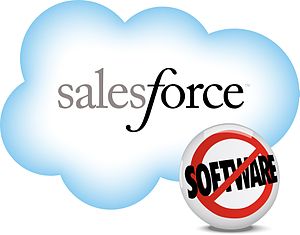 NEWS
NEWS
 NEWS
NEWS
 NEWS
NEWS
![]() If your electric toothbrush comes with GPS and Wi-Fi enabled, Salesforce wants to be the company that manages the data it creates, keeping your dentist informed about your teeth brushing habits.
If your electric toothbrush comes with GPS and Wi-Fi enabled, Salesforce wants to be the company that manages the data it creates, keeping your dentist informed about your teeth brushing habits.
That is the vision behind Salesforce.com’s new strategy announced by CEO Marc Benioff during his keynote at Dreamforce 2013 yesterday. Benioff gave the example of his hi-tech Philips Sonicare toothbrush to illustrate why the company’s new mobile platform Salesforce1, is such a revolutionary concept for the Internet of Things.
“It knows how I’m brushing, how I’m holding it, where it is in the world, because when I go to my dentist’s office, he isn’t going to say, ‘Did you brush?’ He’s going to say, ‘What’s your log-in to your Philips account?’ ” said Benioff.
“It’s going to require a new level of trust with my dentist. It’s a whole new world with my dentist.”
Salesforce adheres to Cisco’s belief that there’ll be around 50 billion connected “things” in the world by 2020. As well as his electric toothbrush, Benioff cited examples such as jet engines, automobiles, windmills and even backhoes.
For Salesforce, it sees the coming of the Internet of Things as a massive opportunity to place its technology at the forefront of companies’ strategies as they embrace this brave new world, and to that end it’s rolled out a revamped version of its cloud-based development platform, known as Salesforce1.
One of the central components of Salesforce1 is its new mobile app. This isn’t the kind of app that too many consumers will want to download. Rather, it’s designed for the enterprise, and consolidates all of Salesforce.com’s major apps, like its flagship cloud service for salespeople, its chat app Chatter, the ExactTarget service for running email/mobile campaigns. It allows users to access customer relationship management (CRM) data, service and support software, plus custom-built applications built with Salesforce technology.
“We are bringing all of your investment, all of your code, everything you’ve done with us into the present,” said Benioff, adding that the app is so powerful that he himself is able to manage the entire company using only his phone.
Salesforce1 also comes with ten times as many APIs, and will target a much wider range of application types, said Benioff. The company’s Force.com platform has now been integrated with Heroku1, its development platform for consumer applications, and this is the kicker. Heroku1 will now be able to access CRM data from Salesforce.com, which companies and developers can use to build new apps that control all of those billions of objects that will make up the Internet of Things. We’ve already seen examples of this, such as with GE, which has placed sensors on its engines and has now built an application to keep track of them. This data can be integrated into Salesforce1 and accessed by employees on the go.
In his keynote, Benioff admitted that not everyone is ready to take advantage of Salesforce1’s capabilities. Rather, the platform has been designed as a way to ‘future-proof’ Salesforce’s technologies and facilitate things that are going to develop over time.
“The platform needs to be build for the developers, ISVs, end users and customers,” Benioff said, noting that Salesforce has blanketed the ecosystem with APIs.
Salesforce no doubt has big ambitions, and the company is clearly a true believer in the Internet of Things, but it remains to be seen how this will play out. Not every consumer will be willing to connected with every single brand and product that they buy – for example, how many of us really want our toothbrush monitoring our habits and informing on us to our dentists?
There are also questions to be answered over consumer identity and analytics. Speaking to SiliconANGLE, Gigya CEO Patrick Salyer noted that Saleforce’s vision misses the importance of identity in creating opportunities for companies with the Internet of Things.
“In his keynote at Dreamforce today Mark Benioff talked about the new Salesforce1 platform, the idea of the ‘Internet of Customers’ and how everything will be connected right down to the toothbrush,” said Salyer.
“While this concept is great in theory, the missing piece of the conversation is identity. As consumers are connecting to more devices through real/social identities from Nike Fuelbands to Nest thermostats, unless there is a standard way for all these devices to communicate, the opportunities are limited. While the Internet of Things continues to grow, identity needs to be a key part of the conversation.”
Another missing piece in this puzzle is analytics – who’s going to crunch all of the data that emerges from Salesforce’s new vision? Benioff made no mention of Big Data during his talk, but it’s a sure bet he would have done if he had the answers.
Saleforce’s deserves credit for its vision, but it could be some years before its plans come to fruition.
THANK YOU